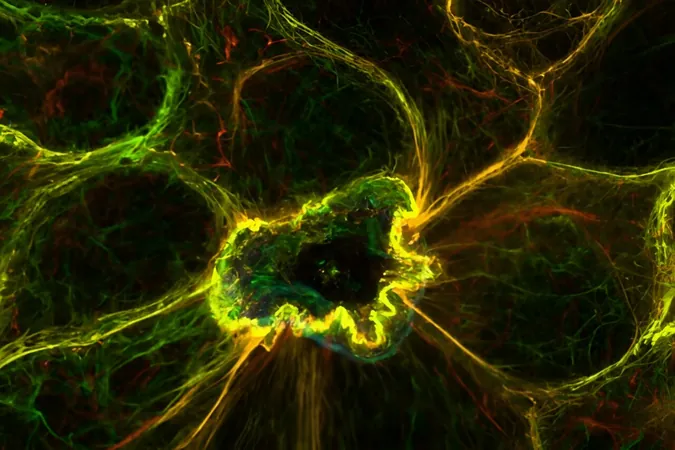
Shocking Discovery: Calcium’s Critical Role in Cell Disposal Unveiled by Japanese Researchers!
2024-10-09
Author: Wei Ling
Introduction
In an eye-opening breakthrough, a team of researchers from Kyushu University, Japan, has unveiled a groundbreaking calcium-mediated mechanism essential for the disposal of dead cells within our bodies. This discovery not only provides insights into how our bodies safeguard against injuries and diseases but also reshapes our understanding of cellular health and homeostasis. Their study, which was published in the prestigious journal *Current Biology*, explored the importance of calcium ion levels in the efficient removal of apoptotic cells from epithelial tissues, using cutting-edge genetic engineering techniques and advanced imaging methods.
Importance of Epithelial Cells
Epithelial cells form protective barriers across various surfaces in our bodies, like the skin and internal organs. When these cells undergo apoptosis—essentially committing cellular "suicide" when damaged—surrounding cells spring into action to expel them, sealing off any potential entry points for pathogens that could lead to infections or inflammation. While the significance of this process has been recognized, the underlying mechanics involved have largely remained enigmatic—until now.
Research Details
The research, spearheaded by Professor Junichi Ikenouchi, along with colleagues Dr. Kenji Matsuzawa and lead author Mr. Yuma Cho, included contributions from experts at the University of Tokyo and the Health Sciences University of Hokkaido. Their innovative approach began with inducing apoptosis in single epithelial cells using a focused laser, allowing the team to monitor how neighboring cells responded in real-time.
As they delved deeper, the researchers introduced specialized calcium ion probes named GCaMP6 to visualize real-time fluctuations in calcium levels. Astonishingly, they observed a pronounced surge in calcium concentration around the membranes of cells adjacent to the dying cells. This remarkable phenomenon was dubbed the “calcium response in effectors of apical extrusion” (CaRE).
Role of IP3 Receptors
The investigation didn’t stop there. The team also scrutinized the role of IP3 receptors, which are intracellular proteins that help manage calcium ion levels. In a striking revelation, they discovered that inhibiting these receptors or knocking out their genes completely halted the removal of apoptotic cells. Utilizing advanced electron microscopy, they identified that a specific subset of IP3 receptors, particularly those located near desmosomes—the crucial cell adhesion structures—was instrumental in the CaRE process.
Desmosomes Function
Think of desmosomes as cellular "buttons"—they hold cells tightly together and are vital for maintaining the integrity of tissues, particularly in regions like the skin and organ linings. By promoting close adhesion among neighboring cells, desmosomes not only stabilize our body's structural makeup but also facilitate cellular cooperation during apoptosis.
Activation of Actomyosin Complex
The activation of IP3 receptors near these desmosomes triggers the contraction of a protein ensemble known as the actomyosin complex. This provokes a transformation in cell shape and prompts cells to migrate, thus enabling the effective removal of dying cells from the epithelial layer.
"This research highlights an unexpected role of IP3 receptors in desmosomal function, which was previously considered solely responsible for mechanical connections among epithelial cells," emphasized Ikenouchi.
Future Directions
While the study was confined to cultured cells, the researchers acknowledge the need for further investigations to determine if the CaRE mechanism operates within live organisms, how it may differ across various organ systems, and what other factors might influence this vital process.
As this pivotal study sheds light on how our bodies maintain a healthy epithelial barrier, it also prompts critical questions about cellular dynamics that many of us often overlook. Stay tuned for more updates on this exciting avenue of research that could revolutionize our understanding of cellular health and disease prevention!






 Brasil (PT)
Brasil (PT)
 Canada (EN)
Canada (EN)
 Chile (ES)
Chile (ES)
 España (ES)
España (ES)
 France (FR)
France (FR)
 Hong Kong (EN)
Hong Kong (EN)
 Italia (IT)
Italia (IT)
 日本 (JA)
日本 (JA)
 Magyarország (HU)
Magyarország (HU)
 Norge (NO)
Norge (NO)
 Polska (PL)
Polska (PL)
 Schweiz (DE)
Schweiz (DE)
 Singapore (EN)
Singapore (EN)
 Sverige (SV)
Sverige (SV)
 Suomi (FI)
Suomi (FI)
 Türkiye (TR)
Türkiye (TR)